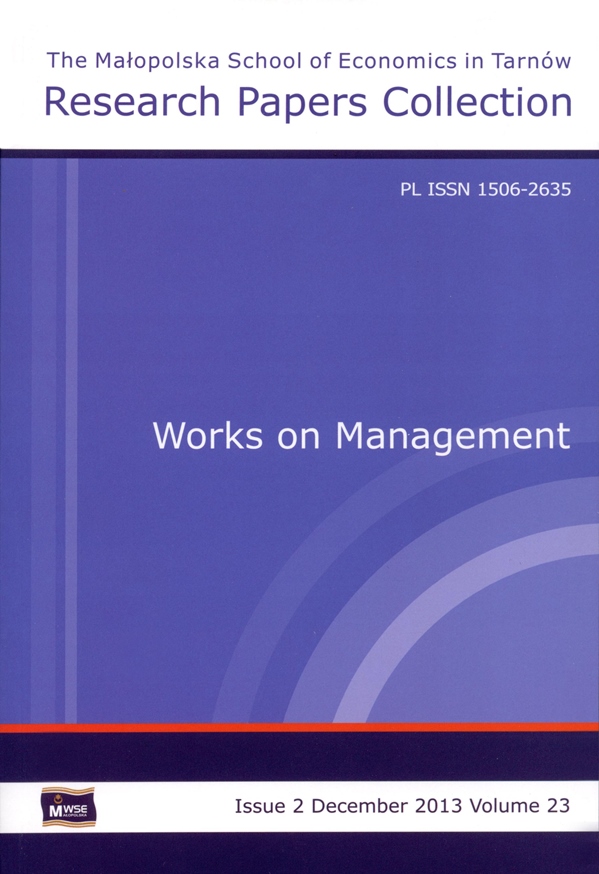Abstract
Contemporary business organizations are facing increasingly turbulent environments, ones dramatically complex and changeable, where changes occur rapidly, are difficult to foresee, and emerge from discontinuous processes. This commonly acknowledged growing turbulence of most organizations’ environments calls for a new kind of action, which would restore at least some control over the environment to decision makers within their organizations. This new kind of action is collecting information in form of weak signals by early recognition systems. Previous body of research strongly suggests that the more strategic uncertainty in the environment is perceived by managers and decision makers, the more advanced early recognition systems tend to be. The system’s advancement is understood as the intensity with which the objective of early recognition is perused. Drawing on the existing research, coming mostly from English-language scholarly literature, as well as the author’s own empirical research conducted among Polish innovative Small and Medium-Sized Enterprises, the author attempts to empirically confirm hypothesized effects the environment perceived as uncertain have on business organizations, that is their proneness to engage in early recognition, as well as the intensity with which they approach the problem of weak signal detection and understanding. To the best of the author’s knowledge, this study is the first to address these assumption in the context of Polish business organizations, and it provides additional supporting proof for the current theory.
References
Ansoff I. Zarządzanie strategiczne. Transl. by K. Obłój, J. N. Sajkiewicz. Warszawa: Państwowe Wydawnictwo Ekonomiczne, 1985.
View in Google Scholar
Ansoff I., McDonnell E. Implanting strategic management. New York: Prentice Hall, 1990. ISBN 0-13-451915-9.
View in Google Scholar
Auster E., Choo Ch.W. “Environmental scanning by CEOs in two Canadian industries”. Journal of the American Society for Information Science, 1993, vol. 44, no. 4.
View in Google Scholar
Bielski M. Organizacje – istota, struktury, procesy. Łódź: Wydawnictwo Uniwersytetu Łódzkiego, 1996. ISBN 83-7016-925-2.
View in Google Scholar
Burns A.C., Bush R.F. Marketing research. Upper Saddle River: Prentice Hall, 2009. ISBN 013-896606-0.
View in Google Scholar
Burns T., Stalker G.M. The management of innovation. Oxford: Oxford University Press, 1994.
View in Google Scholar
Choo Ch.W. Information management for the intelligent organization. Medford: ASIS, 1998. ISBN 1573870579.
View in Google Scholar
Choo Ch.W., Detlor B., Bergeron P., Heaton L. “Working with information: Information management and culture in a professional service organization”. Journal of Information Science, 2006, no. 32 (6).
View in Google Scholar
Czekaj J. Metody zarządzania informacją w przedsiębiorstwie. Kraków: Wydawnictwo Akademii Ekonomicznej, 2002. ISBN 83-7252-067-4.
View in Google Scholar
Daft R.L. Organization theory and design. Saint Paul, MN: West Publishing, 1989. ISBN 0-314-46341-0.
View in Google Scholar
Daft R.L., Sormunen J., Parks D. “Chief executive scanning, environmental characteristics and company performance: An empirical study”. Strategic Management Journal, 1988, vol. 9, no. 2.
View in Google Scholar
Daft R.L., Weick K.E. “Toward a model of organizations as interpretation systems”. Academy of Management Review, 1984, vol. 9, no. 2.
View in Google Scholar
Emery F.E., Trist W.L. “The casual texture of organizational environments”. Human Relations, 1965, vol. 18.
View in Google Scholar
Fahey L., Narayanan V.K. Macroenvironmental analysis for strategic management. Saint Paul, MN: West Publishing, 1986. ISBN 0314852336.
View in Google Scholar
Grote G. Management of uncertainty. Theory and application in the design of systems and organizations. London: Springer, 2009. ISBN 978-1-84882-373-0.
View in Google Scholar
Hambric D.C. “Environmental scanning and organizational strategy”. Strategic Management Journal, 1982, vol. 3, no. 2.
View in Google Scholar
Hamel G., Prahalad C.K. Przewaga konkurencyjna jutra. Transl. by M. Albigowski. Warszawa: Business Press, 1999. ISBN 83-87474-55-X.
View in Google Scholar
Hatch M.J. Teoria organizacji. Transl. by P. Łuków, Warszawa: Wydawnictwo Naukowe PWN, 2002. ISBN 83-01-13541-7.
View in Google Scholar
Kaye D. “The nature of information”. Library Review, 1995, vol. 44, no. 8.
View in Google Scholar
King W.R., Cleland D.I. (eds.). Strategic planning and management handbook. New York: Van Nostrand Reinhold Company, 1987. ISBN 0442247311.
View in Google Scholar
Kirschkamp A. A contingency-based view of chief executive officers’ early warning behavior. Oestrich-Winkel: Deutscher Universität-Verlag, 2006.
View in Google Scholar
Lenz R.T., Engledow J.L. “Environmental analysis units and strategic decision-making: A field study of selected ‘leading-edge’ corporations”. Strategic Management Journal, 1986, vol. 7, no. 1.
View in Google Scholar
Lipshitz R., Strauss O. “Coping with uncertainty: A naturalistic decision making analysis”. Organizational Behavior and Human Decision Processes, 1997, vol. 69, no. 2.
View in Google Scholar
Milliken F. “Three types of perceived uncertainty about the environment: State effect and response uncertainty”. Academy of Management Review, 1987, vol. 12, no. 1.
View in Google Scholar
Morgan G. Obrazy organizacji. Transl. by Z. Wiankowska-Ładyka. Warszawa: Wydawnictwo Naukowe PWN, 1999. ISBN 83-01-12235-8.
View in Google Scholar
Narayanana V.K., Nath R. Organization theory. A strategic approach. Boston: Irwin, 1993. ISBN 0256087784.
View in Google Scholar
Nizard G. Metamorfozy przedsiębiorstwa. Zarządzanie w zmiennym otoczeniu organizacji. Transl. by Z. Podlesiak. Warszawa: Wydawnictwo Naukowe PWN, 1998. ISBN 83-01-12623-X.
View in Google Scholar
Penc-Pietrzak I. “Analiza otoczenia firmy”. Ekonomika i Organizacja Przedsiębiorstw, 2002, no. 11.
View in Google Scholar
Sawyerr O.O. “Environmental uncertainty and environmental scanning activities of Nigerian manufacturing executives: A comparative analysis”. Strategic Management Journal, 1993, vol. 14, no. 4.
View in Google Scholar
Smircich L., Stubbart C. “Strategic management in an enacted world”. Academy of Management Review, 1985, vol. 10, no. 4.
View in Google Scholar
Starczewska-Krzysztoszek M. Ranking najbardziej innowacyjnych firmy w Polsce [online, accessed: 2010-06-01]. Warszawa 2008. Available online: www.innowacyjnefirmy.pl.
View in Google Scholar
Thomson J.D. Organization in action. New York: McGraw-Hill, 1967.
View in Google Scholar
Tushman M.L., Nadler D.A. “Information processing as an integrating concept in organizational design”. Academy of Management Review, 1978, vol. 3, no. 3.
View in Google Scholar
© Copyright by Małopolska School of Economics in Tarnów. The articles are available under the Creative Commons Attribution NonCommercial-NoDerivatives 4.0 International License


